Mr Belligoi has 30 years of experience in emergency care, acute treatment and long-term reconstruction and rehabilitation after facial injury. Injuries to the face, by their very nature, impart a high degree of emotional as well as physical trauma to patients. The science and art of treating these injuries requires special training involving a ‘hands on’ experience and an understanding of how the treatment provided will influence the patient’s long term function and appearance. Injuries can include facial lacerations, intra oral lacerations, knocked-out teeth or fractured cheeks, noses, eye sockets or jaws. Typically, facial injuries are classified as either soft tissue injuries (skin and gums), bone injuries (fractures), or injuries to special regions (such as the eyes, facial nerves or the salivary glands).
Soft tissue injuries
Lacerations to soft tissue are usually repaired by stitches. As well as the obvious concern of having the best cosmetic outcome, care is also taken to inspect for and treat injuries to structures such as facial nerves, salivary glands, and salivary ducts.
Facial bone injuries
In the past, these injuries were treated by wiring the jaw together to supper the broken fragments.
Current treatment uses micro and mini plates to hold the bone in its correct position while it heals and provides more accurate results and earlier return to work and activities.
Teeth and mouth injuries
Isolated injuries to teeth are quite common and may require the expertise of various dental specialists. Oral surgeons usually are involved in treating fractures in the supporting bone or in replanting teeth that have been displaced or knocked out. Injuries are usually treated by some form of splint, such as wiring or bonding teeth together.
If you lose a tooth it should be put in salt water or milk and the sooner it is re-inserted into the dental socket, the better chance it will survive. Therefore, the patient should see a dentist or oral surgeon as soon as possible. You should never try to wipe the tooth off, since remnants of the ligament that hold the tooth in the jaw are attached and are vital to the success of replanting it.

